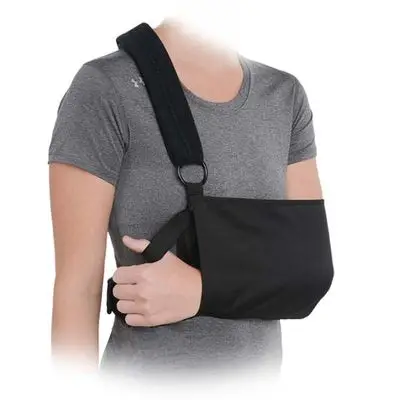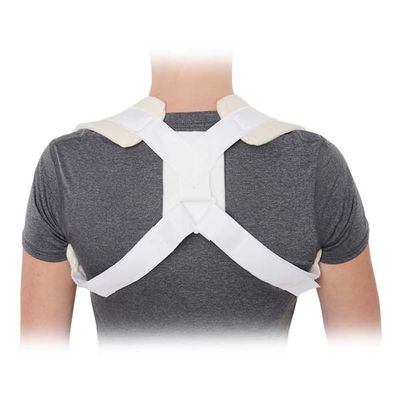Table of Contents
Shoulder Immobilizer
Uses of a Shoulder Immobilizer
Post-Surgery Recovery
- Commonly used after shoulder surgeries such as rotator cuff repairs, shoulder dislocation repairs, or labral surgeries.
- Immobilizes the shoulder to protect surgical repairs and allow proper healing.
Shoulder Dislocation
- Helps stabilize the shoulder joint after dislocation or subluxation (partial dislocation) by preventing excessive movement that could cause re-injury.
Fractures
- Used to support and immobilize fractures of the clavicle (collarbone), scapula (shoulder blade), or humerus (upper arm bone).
Rotator Cuff Injuries:
- Provides support for rotator cuff tears or repairs, helping to limit strain on the affected muscles and tendons.
Severe Sprains or Strains:
- Helps minimize movement in cases of severe shoulder or upper arm strains, reducing pain and promoting healing.
Design and Components
Arm Sling
- Supports the arm and keeps it in place, typically at a right angle to the body. It holds the forearm close to the torso.
Straps:
- Additional straps wrap around the torso and shoulder to ensure the arm and shoulder remain immobilized.
- Some designs feature a waist belt to further secure the arm and prevent unwanted movement.
Padding
- Shoulder immobilizers often include padded sections for comfort, especially around the neck and shoulders to prevent pressure sores or discomfort from prolonged use.
Types of Shoulder Immobilizers
Standard Shoulder Immobilizer
- Basic design with a sling and straps that secure the arm close to the body, preventing shoulder movement.
Abduction Shoulder Immobilizer
- This type of immobilizer includes a pillow or wedge that holds the arm away from the body in an abducted position, commonly used after more complex shoulder surgeries.
Shoulder Immobilizer with Abduction Pillow
- An advanced version that combines a standard immobilizer with an abduction pillow, ensuring the shoulder is held in an optimal position for recovery.
Benefits of a Shoulder Immobilizer
- Immobilization: Prevents movement in the shoulder joint, reducing the risk of reinjury and allowing the area to heal properly.
- Pain Reduction: By keeping the shoulder and arm stable, the immobilizer helps reduce pain and discomfort.
- Post-Surgery Protection: Protects surgical repairs by limiting movement, especially in the early stages of healing.
- Promotes Healing: Immobilizing the shoulder reduces strain on injured or healing tissues, promoting faster recovery.
Proper Use and Tips
- Follow Doctor’s Instructions: It’s crucial to wear the shoulder immobilizer as prescribed by your healthcare provider. They will guide you on how long to wear it and when it is safe to begin rehabilitation exercises.
Ensure Proper Fit: The immobilizer should be snug but not too tight. A poorly fitted immobilizer can cause discomfort or even lead to further complications.
Avoid Moisture: Keep the immobilizer dry to prevent skin irritation or infection, especially if the device is worn for extended periods.
Exercise Caution When Moving: Avoid sudden or jerky movements that could strain the shoulder, and follow proper guidelines when removing or adjusting the immobilizer.
Care During Sleep: Some patients may need to wear the shoulder immobilizer while sleeping. Be sure to find a comfortable sleeping position that keeps the shoulder immobilized, typically on the back with pillows for support.
Recovery Process
The shoulder immobilizer is usually worn for a specific duration depending on the severity of the injury or surgery. Over time, physical therapy may be introduced to restore shoulder mobility and strength once healing has sufficiently progressed.
A shoulder immobilizer is a critical part of the healing process for many shoulder-related injuries and surgeries, helping to keep the joint stable and safe while recovery takes place.
Shoulder & Elbow Brace
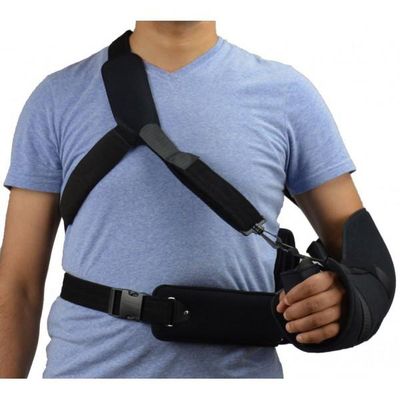

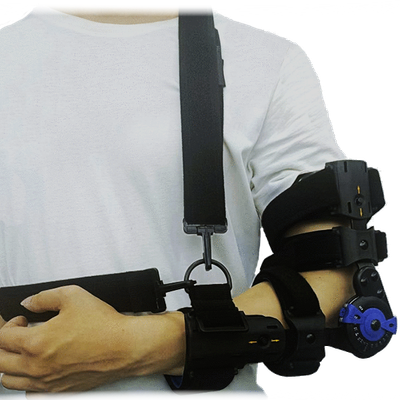
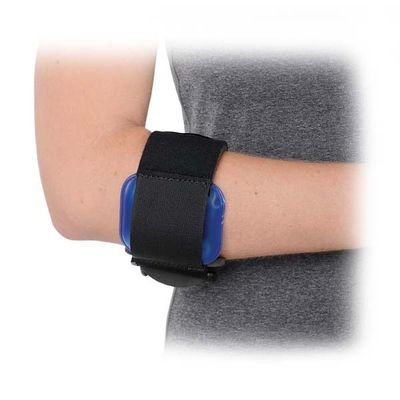
Shoulder pain is a common issue that can result from a variety of causes, including injuries, overuse, or underlying medical conditions. The shoulder is a complex joint with a wide range of motion, making it susceptible to different types of injuries or wear and tear. Shoulder pain may affect the muscles, tendons, ligaments, or bones within the shoulder joint, and can range from mild discomfort to severe pain.
Common Causes of Shoulder Pain
Rotator Cuff Injuries
- Cause: The rotator cuff consists of four muscles that help stabilize and move the shoulder. Injuries like tears or inflammation can cause pain.
- Symptoms: Dull ache deep in the shoulder, difficulty lifting the arm, and weakness in the shoulder.
- Treatment: Physical therapy, anti-inflammatory medications, and in severe cases, surgery.
Shoulder Impingement:
- Cause: The rotator cuff tendons get trapped and compressed during shoulder movement, leading to inflammation.
- Symptoms: Pain when lifting the arm or reaching behind the back, as well as weakness and difficulty with overhead activities.
- Treatment: Rest, physical therapy, and anti-inflammatory medications.
Frozen Shoulder (Adhesive Capsulitis)
- Cause: Stiffness and pain in the shoulder joint due to inflammation and scar tissue buildup. The exact cause is often unknown but can occur after an injury or period of immobility.
- Symptoms: Restricted range of motion and pain, especially when trying to move the arm.
Treatment: Physical therapy, anti-inflammatory medications, and corticosteroid injections. Severe cases may require surgery.
Tendinitis
- Cause: Inflammation of the tendons in the shoulder, often from repetitive overhead movements or aging.
- Symptoms: Pain and tenderness in the front of the shoulder, especially during movement.
- Treatment: Rest, ice, and anti-inflammatory medications, followed by physical therapy to restore function.
Bursitis
- Cause: Inflammation of the bursa (a fluid-filled sac that cushions the joint) due to repetitive motion or overuse.
- Symptoms: Pain, swelling, and tenderness around the shoulder joint, especially with movement.
- Treatment: Rest, ice, and anti-inflammatory medications. In some cases, corticosteroid injections may be recommended.
Shoulder Dislocation
- Cause: When the upper arm bone (humerus) pops out of the shoulder socket, usually due to trauma or a fall.
- Symptoms: Intense pain, visible deformity, and inability to move the shoulder.
- Treatment: Medical attention is required to relocate the shoulder. Physical therapy is usually needed after to restore strength and prevent recurrence.
Shoulder Arthritis
- Cause: Degeneration of the cartilage in the shoulder joint, commonly due to osteoarthritis or rheumatoid arthritis.
- Symptoms: Pain, stiffness, and swelling in the shoulder joint, particularly after periods of rest or prolonged use.
- Treatment: Pain management with anti-inflammatory medications, physical therapy, and in advanced cases, joint replacement surgery.
Fractures
- Cause: Breaks in the bones of the shoulder (such as the collarbone, humerus, or scapula) usually due to falls or accidents.
- Symptoms: Severe pain, swelling, bruising, and inability to move the shoulder.
- Treatment: Immobilization with a sling or shoulder immobilizer, followed by physical therapy. In some cases, surgery may be required.
Labral Tear
- Cause: The labrum is the cartilage that surrounds the shoulder socket. Tears can occur from injury or overuse, particularly in athletes or those doing repetitive overhead activities.
- Symptoms: Deep pain, clicking or catching sensation in the shoulder, and weakness or instability.
- Treatment: Physical therapy or surgery depending on the severity of the tear.
Referred Pain from the Neck
- Cause: Conditions such as cervical radiculopathy (pinched nerves in the neck) can cause pain that radiates down into the shoulder.
- Symptoms: Pain that radiates from the neck to the shoulder, numbness or tingling, and weakness in the arm.
- Treatment: Addressing the underlying neck condition through physical therapy, medications, or in severe cases, surgery.
Treatment for Shoulder Pain
Rest and Activity Modification
- Avoid activities that worsen the pain, especially repetitive overhead movements or heavy lifting.
Ice/Heat Therapy
- Ice packs can help reduce inflammation and numb pain, especially after acute injury. Heat can help relax stiff muscles and improve blood flow in chronic conditions.
Physical Therapy
- Targeted exercises to strengthen the shoulder muscles, improve range of motion, and restore joint function.
Anti-Inflammatory Medications
- Non-steroidal anti-inflammatory drugs (NSAIDs) such as ibuprofen can help reduce pain and swelling.
Corticosteroid Injections
- For more severe inflammation, corticosteroid injections may provide relief, especially for conditions like bursitis or tendinitis.
Bracing or Sling Use
- For fractures, dislocations, or severe strains, a sling or shoulder immobilizer may be required to restrict movement and allow healing.
Surgery
- In cases of severe injury, such as rotator cuff tears, labral tears, or advanced arthritis, surgery may be necessary to repair or replace damaged tissues.
When to See a Doctor
- Severe pain or inability to move the shoulder.
- Swelling or deformity following trauma or injury.
- Persistent pain that does not improve with rest or over-the-counter treatments.
- Numbness or tingling in the arm, which could indicate nerve involvement.
- Pain radiating to the chest or down the arm, which may signal a more serious condition, such as a heart attack.
Shoulder pain can be complex, so it’s important to get a proper diagnosis from a healthcare professional to ensure appropriate treatment and recovery.

